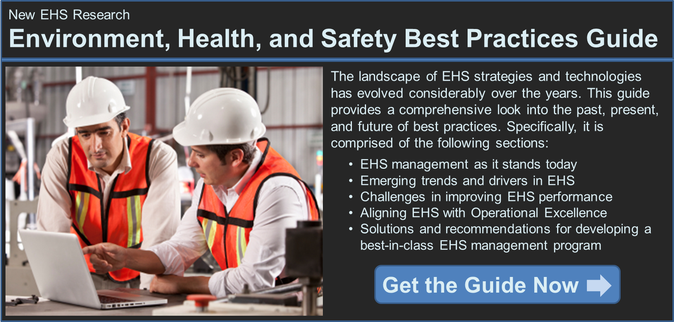 If some self-proclaimed tech prophets are correct, in a couple of years you’d be reading an article like this on some form of wearable technology. These prognostications are a little strong, and while the hype over wearable tech may be vast, it would be folly to underestimate its potential.
If some self-proclaimed tech prophets are correct, in a couple of years you’d be reading an article like this on some form of wearable technology. These prognostications are a little strong, and while the hype over wearable tech may be vast, it would be folly to underestimate its potential.
We’ve seen many demonstrations on how wearable tech could change our personal lives, but how about wearable tech’s impact on the workplace? In particular, are there uses for these products within an environment, health and safety (EHS) context? Short answer: yes. Before we discuss how wearable tech will influence the workplace from an EHS perspective, let’s look at why the idea has become so popular.
The Revolution Will be Wearable
In spite of all the advancements we’ve seen with devices like smartphones and tablets, now ostensibly mundane devices like watches and glasses are all the rage. Why? Because they’re connected. In most cases, these small, lightweight devices are linked to that modern mainstay of our pocket: the smartphone. In the last two years, we’ve seen the emergence of wearable devices like smartwatches as well as augmented reality devices like Google Glass.
The devices carry the capacity to provide much of the same information we’re able to glean from our mobile devices, yet in uniquely accessible ways. While we would scarcely describe the use of devices like smartphones as cumbersome, increasingly tech manufacturers are asking us to think about the limitations of these devices.
The applications of wearable tech in our day-to-day lives are certainly intriguing and, after a few years of development and maturity we may even see something like the smartwatch eclipse the smartphone in terms of basic functionality. But let’s take the trend towards wearables a step further and look at the ways wearable tech is poised to directly impact the workplace from an EHS perspective. After all, this is where wearables bear the greatest potential to improve the most important aspects of our collective well-being: the health of individual workers, the mitigation of safety hazards, and the reduction of harmful environmental impacts.
1. Health and Environmental Monitoring
Every year about this time, the Occupational Health and Safety Administration (OSHA) in the U.S. launches a campaign to alert individual workers and employers about the hazards of high-temperature environments. These campaigns ask workers to take note of their individual temperatures, take breaks, and stay hydrated. They also ask employers to implement heat-related policies to ensure workers aren’t overexposed to high temperatures.
Heat is just one example, but it is a good lens into the potential of wearable technology in the workplace from a health perspective. Think about the possibilities a device—be it a watch-like unit or a waist band or an otherwise applied sensor—could have in these kinds of situations. Instead of a worker manually gauging their condition against environmental factors, a wearable device could simply alert them and the employer at the right time, once a threshold had been crossed.
It wouldn’t be up to the employee or the employer to determine if the worker was exposed to unsafe conditions. The health monitoring device would back up all we’d need to see with real-time hard data. There’s also clear possibilities here in terms of personal protective equipment (PPE) which could provide biofeedback alerts when we’re in dangerous and high-stress situations.
The associated uses of devices like this are plain, if not monumental in their applications to improve employee health and safety. Think heart rates, unsafe sound levels, ergonomics, and air quality, for example. Fortunately none of this is rocket science. All of the required sensors are either already available if not already integrated into that phone in your pocket. It is just a matter of aligning these elements to achieve the purpose of improving worker health.
2. Augmented Reality
I recently had the opportunity to see a demonstration of a Google Glass-like device used in industrial and manufacturing environments. The conceptual pitch depicted a man, called to a power-outage emergency at a stadium where, with the aid of a dispatcher and a head-mounted visual augmentation device, was able to effortlessly determine the cause of the outage and repair it accordingly, thanks to visual cues provided by the head-mounted device.
Examples like this are really not far off the mark. Indeed, some manufacturers have actually implemented augmented reality devices and are deriving value from them.
This may seem sci-fi in nature, but we are within reach of realizing an environment where our frontline workers go about day-to-day duties with cues facilitating every action on the plant floor. If they wear augmented devices and walk past, maybe a machine guard under investigation, or a pipe fitting that is releasing noxious gas, they could be alerted with visual aids. And, as with the example indicated earlier, a first responder to a plant emergency could be assisted with the help of a visual augmentation device, as well as the support of a dispatcher who could be able to see what the responder is seeing.
3. Communication
As a long-time Star Trek fan, one thing I've appreciated is how the computer in the series was simply pervasive and ubiquitous. It was everywhere, at once. All a user had to do was say “computer” and provide a question or command.
We are really not far off from having this capability, but I believe it highlights the difference between the cumbersome nature of pulling out a smartphone, getting past a lock screen, and then manually dialing a number to get in touch with a pertinent party. Imagine, in the midst of a critical (or noncritical, for that matter) situation, we simply call ‘computer’ or some other keyword into the air to establish immediate contact with an appropriate party.
As most smartphone users know, there is some psychological if not functional barrier that often prevents us from pulling out our mobile devices to communicate what may or may not be essential information to another party. By facilitating ease of use and accessibility, wearable tech is poised to make communication between frontline workers, managers, and executive personnel that much more seamless.
4. Access to Personalized Data
Right now, our phones tell us pretty much anything we might need to know, from what to wear to work, to sports scores, to the political situation in Eastern Europe.
Internally, within our organizations, we have access to vast amounts of data pertinent to all our daily jobs. So imagine that the ‘macro’ Google Now or Siri becomes micro and is able to provide role-based information and user experience that is personalized to the individual. Devices will use machine learning to base the information we’re given on previous use of the system as well as environmental conditions collected by wearables, truly personalizing the experience and delivering the most relevant information. Immediately relevant information will be at our fingertips, or on our wrists, or perhaps on the bridges of our noses.
Of course, the road to widespread adoption of wearable tech will not be without its challenges. For example, from a legal perspective, there’s the issue of what employee information an employer can actually monitor and whether or not certain information can be saved for future analysis or disciplinary action. This will differ both by country and the strength of regional labor unions and laws. In some places it may be very difficult to collect or save this information while others will have few limitations.
